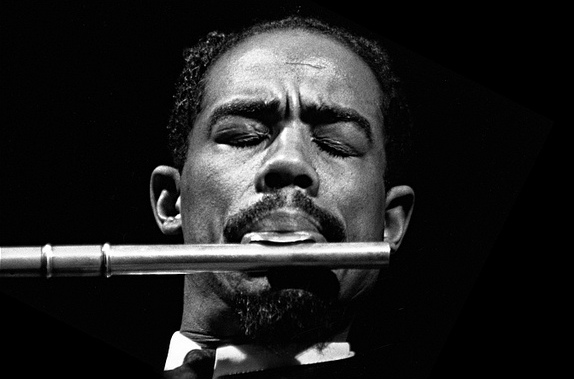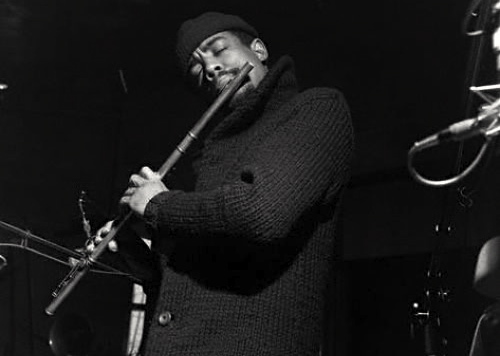
Eric Allan Dolphy, Jr was born on June 20, 1928 in Los Angeles, California and passed away on June 29, 1964 in Berlin, Germany.
Dolphy’s earliest musical experiences came when he attended the local church with his mother, who was a choir member. The boy also became a choir member of the People’s Independent Church of Christ. He started playing the clarinet when he was in first grade, and by the time he had turned eight he joined his school’s band. In junior high school Dolphy started playing the oboe and the alto saxophone. His parents converted their garage into a soundproof room so the young musician could practice. He learned the alto my imitating the sounds of Charlie Parker, his earliest influence.
Dolphy graduated from high school and enrolled in classes at Los Angeles City College. At the age of twenty, Dolphy joined a band, The 17 Beboppers, which was led by drummer Roy Porter. He performed with the group through the year 1950, when he enlisted in the United States Army. Dolphy subsequently spent two years in the service and was stationed in Washington D.C. He briefly studied music at the United States Naval School in 1953.
After his return to Los Angeles Dolphy led his own group for several years. In 1958, he joined Chico Hamilton’s band. Dolphy made appearances on a handful of Hamilton’s releases, which included Chico Hamilton with Strings Attached. The group’s performance at the Newport Jazz Festival in 1958 was subsequently released on the compilation album Newport Jazz Festival 1958-59, , which includes the track Blue Sands. Hamilton’s band broke up in 1959, and Dolphy stayed in New York City where he quickly found work.
He joined bassist Charles Mingus’s group in late 1959, and the pair formed a close musical bond. In1960 He appeared on the Mingus albums Pre-Bird and Charles Mingus Presents Charles Mingus. Featured on the latter were the songs All the Things You Could Be By Now if Sigmund Freud’s Wife Was Your Mother and Original Faubus Fables.
Dolphy’s recorded output in 1960 is quite astonishing. He played with Rat Pack vocalist Sammy Davis Junior on his 1960 release for Decca, I Gotta Right to Swing. Also in 1960, Dolphy released his first album as a leader, Outward Bound, which featured pianist Jaki Byard, drummer Roy Haynes, and trumpeter Freddie Hubbard. Among the tracks on this album which made listeners sit up and pay attention are On Green Dolphin Street and Glad to be Unhappy.
1960 was only halfway through, and Dolphy was not done yet. He recorded another album as a leader, Out There, on August 15th. Four days later, he stepped back into Rudy Van Gelder’s New Jersey studio to record with the Latin Jazz Quintet for the joint release Caribe. In late 1960, Dolphy recorded a duo album with bassist Ron Carter and performed on Gunther Schuller and John Lewis’s album Jazz Abstractions, which featured contemporary classical music. As if this weren’t enough, Dolphy recorded the album Far Cry, which featured the song Tenderly.

Of course, by 1960 Ornette Coleman was also in New York, and experimenting with the style that became known as “free jazz.” Dolphy can be found on Coleman’s album for Atlantic which consecrated this movement, Free Jazz. Among the musicians who collaborated on this landmark recording, which featured two quartets, each recorded in a separate stereo channel, are trumpeter Freddie Hubbard, bassist Scott LaFaro, drummer Billy Higgins, trumpeter Don Cherry, and bassist Charlie Haden. They are featured on such songs as First Take.
In 1961, Dolphy recorded with bandleader Oliver Nelson on his album The Blues and the Abstract Truth, which contained the now famous jazz standard Stolen Moments and Hoe Down. Dolphy also made a memorable appearance on pianist George Russell’s album Ezz-thetics, which featured Thelonious Monk’s Round Midnight.
1961 was also the year that Dolphy began his relationship with John Coltrane. Dolphy’s playing on the Coltrane albums Africa/Brass and Ole Coltrane, both recorded in May, cemented the reputations of both players. Joined by pianist McCoy Tyner, trumpeter Freddie Hubbard, and bassist Reggie Workman, the pair can be heard on Aisha and Ole. Dolphy performed with Coltrane’s group throughout the year, including at the tenor saxophonist’s four-night engagement at New York’s Village Vanguard in November, which became the album Live at the Village Vanguard. Among the recordings from these sessions are India, Spiritual and Chasin Another Trane.
While playing with Coltrane, Dolphy also performed in July of 1961 with trumpeter Booker Little at New York’s Five Spot and can be heard on the song Fire Waltz from the album Eric Dolphy at the Five Spot. Dolphy’s November, 22nd concert with Coltrane in Helsinki can be heard on the track Impressions.
From 1962 to 1964, Dolphy primarily performed and toured with Charles Mingus. In October of 1962, Dolphy appeared at New York’s Town Hall with a group assembled by Mingus. The concert was recorded and issued on Blue Note as The Complete Town Hall Concert. In 1963, Dolphy appeared on the Mingus album Mingus, Mingus, Mingus, Mingus, Mingus and is heard on the songs Hora Decubitus and II B.S.

Increasingly, Dolphy began to favor the bass clarinet, as can be heard on his 1963 release Iron Man. This album contained some riveting solos which are extremely unpredictable and yet vulnerable. In February of 1964, Dolphy entered Van Gelder Studios to record his first album for Blue Note, Out to Lunch. Adored by fans, musicians, and critics, the album was one of the first to be recorded entirely of free jazz, yet also offered Dolphy’s intervallic approach as an alternative to Coleman’s motivic, gestural approach to free improvisation.
Dolphy’s innovations as an improviser can be heard on the songs Straight Up and Down, Something Sweet, Something Tender and Gazzelloni.
Dolphy’s tour with Mingus the spring and early summer of 1964 would be his last. He died on June 28th of that year in Berlin, Germany, of complications from diabetes. The density of Dolphy’s contributions to the advancement of jazz in his short career stand unmatched by almost any musician. His efforts helped put the free-jazz movement on a firm musical foundation and point it towards the future.
